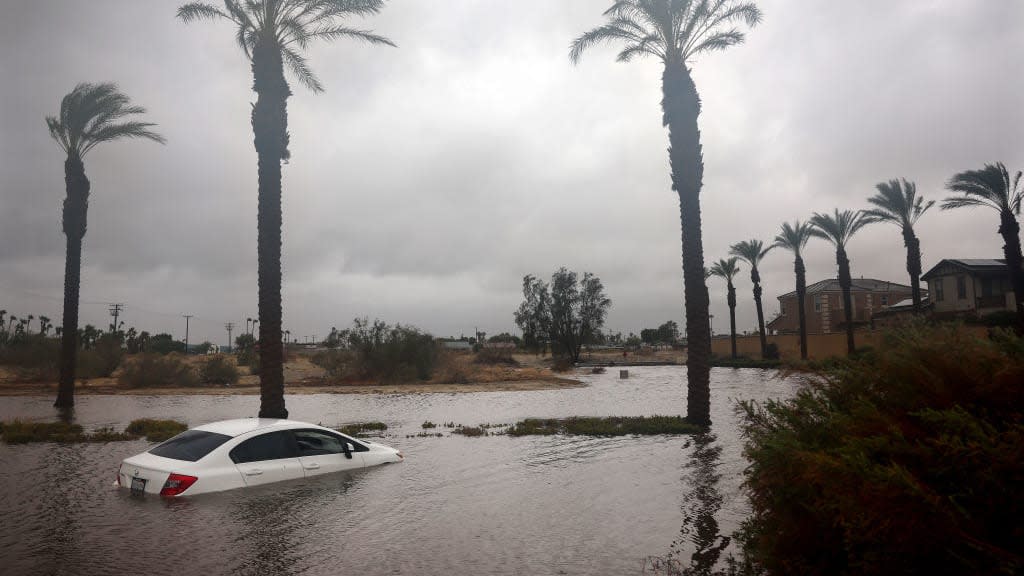‘Frightening’ Tropical Storm Hilary Turns Dodger Stadium Into a Lake

The tropical system that was once Hurricane Hilary dumped a years’ worth of rain in some areas of Southern California on Sunday, delivering shocking footage of flooding, mudslides, and damage to what’s usually one of the country’s driest regions.
Hilary, once a Category 4 hurricane before weakening, became the first tropical storm to strike Southern California in 84 years when it made landfall on Sunday in a region with infrastructure that isn’t designed to handle heavy rainfall.
Among the eeriest scenes was outside Los Angeles’ iconic Dodger Stadium, with aerial footage showing the ballpark—nicknamed Chavez Ravine for its low elevation compared to surrounding areas—completely surrounded by floodwaters.
Aerial view of Dodger stadium yesterday pic.twitter.com/emte2Gcn07
— Jomboy Media (@JomboyMedia) August 21, 2023
Roadways essential for evacuations and first responders had become rivers by Monday morning. Interstate-10, which runs across from Los Angeles west across the country, was closed in both directions in Palm Springs on Monday due to mudslides.
This is I-10 through Palm Springs, CA covered in mud. The highway remains CLOSED in both directions due to mudslides and debris flow. pic.twitter.com/vFM1owwT6o
— WeatherNation (@WeatherNation) August 21, 2023
Parts of the Los Angeles metro area received over seven inches of rain overnight—a sharp contrast to the next-to-zero rainfall the region typically experiences in August, which is Southern California’s driest month of the year.
🌊🪦🇺🇸 - #DeathValley, the hottest and driest place in the #US just saw the 4th 1-in-1,000 year rain event in less than 2 weeks in the US.
3/4 of Death Valley’s annual rainfall fell in 3 hours.
St Louis on July 25-26, Eastern Kentucky on July 28, Southern Illinois on August 2… pic.twitter.com/0L6wVNZrw5— 🔥🗞The Informant (@theinformantofc) August 21, 2023
Death Valley, infamously known as the hottest and driest area in the U.S., was inundated with three inches of rain overnight—eclipsing its average annual rainfall total of 2.2 inches in just three hours. Videos from the national park, which was closed Monday, showed floodwaters racing through areas that are typically barren desert.
Despite warnings last week to evacuate or shelter in place, scores of Californians were left stranded by Hilary’s floodwaters, with firefighters dispatched to pull people from flooded cars, according to the Desert Sun.
Videos throughout Los Angeles, Palm Springs, and San Diego showed drivers stuck in their vehicles as water overtook roadways and crumbled portions of others. Others showed empty flowerpots racing down streets in floodwaters, likely swept away from the yards and front porches of homes.
Hurricane Hilary is hitting Palm Desert and Palm Springs hard right now… my mom just sent me this video. I grew up there, family still lives there. #HurricaneHilary pic.twitter.com/v9GBg9RC9d
— Matt Roy (@MattRoy_TV) August 21, 2023
Despite widespread damage, there were no reported deaths in Southern California by Monday morning. One man died in floodwaters caused by Hilary in Baja California, Mexico, on Sunday.
The full scope of injuries aren’t likely to be known until later Monday, however, as many areas—like Palm Springs, a city of 45,000—shut down 911 operations entirely on Sunday night.
Footage on Monday showed the sign for Palm Springs’ airport had been washed out of place, and downed trees littered roadways and ritzy resorts near Joshua Tree National Park.
Palm Springs is completely flooded by Hurricane Hillary. pic.twitter.com/PoWRNNhqoW
— Project TABS (@ProjectTabs) August 21, 2023
Palm Springs Mayor Grace Garner said Monday morning that 911 service had been restored, but she begged residents to stay at home while rescue and cleanup operations begin.
“Yes, there’s going to be sun today, and that’s fantastic,” she said. “However, we have a lot of clean-up to do, we need to assess the damage, and if the roads are clear that makes our job that much easier and we’re able to get those roads open much faster if people just stay in place.”
Flood watches and warnings are still in effect in some parts of the Southwest as heavy rain continues.
We're LIVE with the latest on #Hilary and the other tropical storms that are brewing. pic.twitter.com/qq83cbMgXV— The Weather Channel (@weatherchannel) August 21, 2023
Many won’t have a choice but to stay in place. Nancy Ross, a councilwoman for Cathedral City in California, told the Desert Sun that three feet of water rushed into homes in her neighborhood—a community for people 55 and older. The fire department arrived Monday to evacuate residents trapped by the water.
“There was in several locations at least three feet of rushing water that was like a river and had a current of its own, it’s frightening,” Ross said. “And that rushing water by nature just wanted to follow a straight path up into people’s driveways and into their garages, and so many people flooded.”
Get the Daily Beast's biggest scoops and scandals delivered right to your inbox. Sign up now.
Stay informed and gain unlimited access to the Daily Beast's unmatched reporting. Subscribe now.

